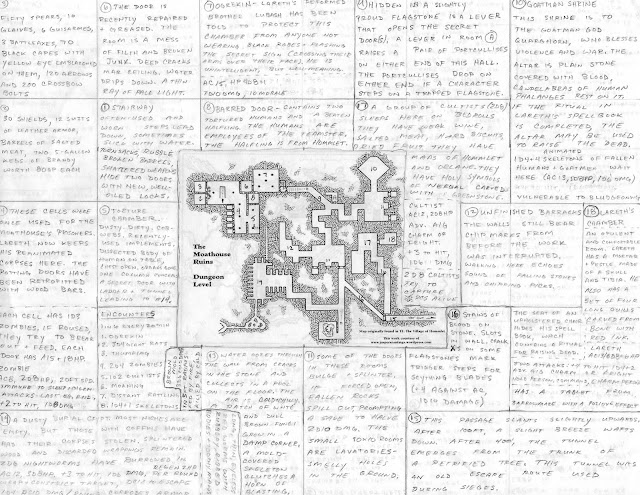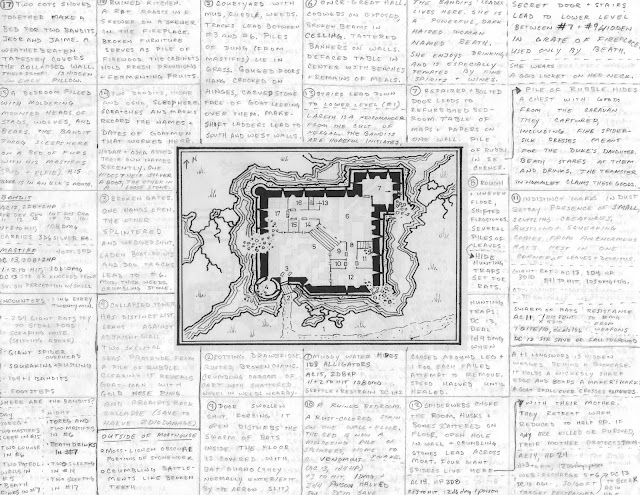Last post, we converted the Village of Hommlet into a one-page
dungeon. We have two design goals when hacking T1: to present its information
in a more GM-friendly format and to add depth to its content.
Additionally, I also have a third design goal as I
prepare my iteration of the adventure. I plan to replace the Temple of
Elemental Evil with the Barrowmaze by Greg Gillespie, so that will require changing some story elements to make the adventure fit.
This post will contain spoilers for both the adventure T1:
The Village of Hommlet and Barrowmaze, so please be mindful of
reading ahead if you play in a campaign that features either of these adventures.
So here’s the story: I’m replacing Ironguard Motte in the
Duchy of Aerik (the setting provided by Barrowmaze) with the village of
Hommlet. The moathouse will be two hexes (twelve miles) away along the Moorwash
River. The player characters will be adventurers come to collect a bounty on
the bandits living in the moathouse.
 |
| This map is from Playing Dice at the Universe, but I altered Ironguard Motte to read as "Hommlet." The moathouse is in hex 0703. |
The bandits have ambushed travelers along the road
between Hommlet and Helix for a while now, but they recently absconded with a
delivery of spider-silk dresses intended as a gift for a lady the Duke’s son is
courting. The Duke’s son, being an entitled, cowardly, and proud young man, has
placed a bounty of silver pieces on each bandit and a reward for returning the
dresses. The bandits are worth more alive than dead, as the Duke’s son would
like the pleasure of publicly humiliating them before sentencing them to death.
Next, here’s an idea from Seth Skorkowsky’s review of The Village of
Hommlet: the bandits are hopeful initiates for an evil cult. Lareth the Beautiful
is a cult member living under the moathouse who will initiate the bandits once
they satisfy his demands.
Because I’m replacing the Temple of Elemental Evil with
Barrowmaze, I think I can make Lareth the Beautiful a member of the Cult of
Nergal or Orcus. That would make Lareth a necromancer, so my idea is that he’s
tasked the bandits to bring him live captives to reanimate as undead.
Another idea I have is that Lareth is interested in
necromancy to prolong his youth and beauty (if you’ve watched Game of Thrones,
you can likely guess where I got this idea from). So Lareth is a vain, young,
attractive man with selfish motives for worshipping his unholy god.
So, what about the moathouse itself? Here’s a picture of
my notes on it:
Credit goes to the Thought Eater podcast for the map of
the moathouse, who in turn got it from Spikepit.
Like the Village of Hommlet, I’ve annotated the map. My
notes all fit on a single side of a sheet of paper. Although the layout of the
moathouse is the same, I’ve made several changes to its content:
·
I used the Ruined Castle tables by the Raging Swan to add setting details. These hint that the
moathouse was originally constructed by the goat-men of lord Fragglehorn (from
Gavin Norman’s Dolmenwood campaign setting).
·
I replaced the giant frogs outside the
entrance with alligators. My idea is that they will surprise reckless player
characters that try to jump across the rocks and enter the castle through the
broken walls.
·
I’ve replaced two of the bandits with two massive
dogs (as wolves) to provide a bit more variety to any combat that takes place
with them.
· I took out the giant tick and the giant lizard. I’ve also moved some creatures around, such as the giant
spiders and giant rats. Each pair of bandits now has their own room, save for
the leader (who has a room to herself) and one who shares a room with the two
dogs.
The idea here is that the bandits spend most of their
time in rooms 6, 7, and 13-17, while rooms 8-12 remain in the hands of vermin.
Next, here’s my annotated map of the dungeon level.
 |
Credit goes to Jasper’s
Rantings on Wordpress for the map I used. Here’s some key changes from the
original:
·
Removed the green slime from the stairs
leading to the surface.
·
Replaced the ghouls with nightworms (from
Gavin Norman’s Dolmenwood).
·
Replaced the giant crayfish with a brown mold.
·
Replaced the bugbears and gnolls with animated
skeletons
·
Added detail to room #10.
·
Replaced the false door traps in areas #11
because they didn’t make much sense to me. They now lead to collapsed rooms.
The trigger for the portcullis in area #9 is now a slightly proud stone in the
hallway.
Here’s
some final musings and lessons learned from this process:
·
I appreciate the “one-page dungeon” layout
and design philosophy. It makes descriptions of rooms easy to access and
interpret at the table. It also compels you (the GM) to put only relevant
information in your notes. While this format would likely not work expansive
locations or those dense with detail, it served well in T1 to unpack the dense
prose and counter-intuitive formatting early modules came with.
·
Preparing to run Barrowmaze has me thinking
about the differences between the cults of Nergal and Orcus, as well as the
nature of necromancy in my campaign setting. Necromancy is always something I’ve
taken for granted – magic-users cast spells that reanimate dead, and that’s
that. However, if I plan on running a campaign that involves as many undead as
Barrowmaze, I think it would be worthwhile to devote some thought and energy to
the intricacies of necromantic magic and the differences between the two cults.
I likely will make another post about that in the future.
·
Besides connecting T1 to the moathouse, I
think I could also run Bogtown (also from the Duchy of Aerik) as Orlane from N1:
Against the Cult of the Reptile God. I could replace the cult of Explicita
Defilus with a cult of Nergal or Orcus, though I could also simply keep that
cult and have the lizardfolk and troglodytes of the Barrowmoor get involved.
Anyway, that’s all I have for this post. If you have
suggestions or find these maps helpful, please let me know in the comments!


